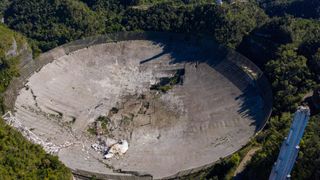You can destroy a good telescope, but you can’t keep it turned off. Using data from the now-destroyed Arecibo radio telescope, scientists at the Search for Extraterrestrial Intelligence (SETI) Institute have uncovered the mysteries of signals from “cosmic lighthouses” powered by dead stars.
Specifically, the team led by Sophia Sheikh of the SETI Institute was interested in how signals from pulsars are distorted as they travel through space. Pulsars are dense stellar remnants called neutron stars that shoot beams of radiation across the universe as they spin.
To study how signals from these stars are distorted in space, the team turned to archival data from Arecibo, a 1,000-foot (305-meter) wide suspended radio dish that collapsed on Dec. 1, 2020, when the cables supporting it snapped, tearing holes in the dish.
The researchers examined 23 pulsars, 6 of which had not been studied before. This data revealed patterns in the pulsar signals that indicate how they were affected by passing through the gas and dust that exists between stars, called the “interstellar medium.”
When the cores of massive stars rapidly collapse to form neutron stars, they can create pulsars capable of spinning up to 700 times every second due to the conservation of angular momentum.
When pulsars were first discovered by Jocelyn Bell Burnell in 1967, some proposed the persistent and highly regular periodic pulsations of these remnants to be signals from intelligent life everywhere in the universe. Just because we now know that this is not the case does not mean SETI has lost interest in pulsars!
The team was interested in the radio wave distortions, known as diffractive interstellar scintillations (DISS). DISS is somewhat similar to the pattern of wavy shadows seen at the bottom of a pool when light passes through the water above.
Rather than waves in water, DISS is caused by charged particles in the interstellar medium that cause distortions in the radio wave signals traveling from pulsars to radio telescopes on Earth.
The team’s investigations showed that the bandwidth of the pulsar signals was much wider than current models of the universe suggested. It also showed that current models of the interstellar medium may need to be revised.
The researchers found that the DISS data were better explained when galaxy structures, such as the Milky Way’s spiral arms, were taken into account. This suggests that challenges in modeling our galaxy’s structure must be addressed in order to continually update galaxy structure models.
Understanding how signals from pulsars work is important to scientists because, when considered in large arrays, the ultraprecise periodic signals from pulsars could be used as a timing mechanism.
Astronomers use these “pulsar timing arrays” to measure tiny distortions in space and time caused by the passage of gravitational waves. A recent example is the use of the NANOGrav pulsar array to detect a faint signal from the gravitational wave background.
This background sound of gravitational waves is thought to be the result of supermassive black hole binaries and mergers in the very early universe. A better understanding of DISS could help with the detection of gravitational waves by projects like NANOGrav.
“This work demonstrates the value of large, archived datasets,” Sheikh said in a statement. “Even years after the Arecibo Observatory’s decommissioning, its data continue to unlock important information that can advance our understanding of the galaxy and enhance our ability to study phenomena like gravitational waves.”
